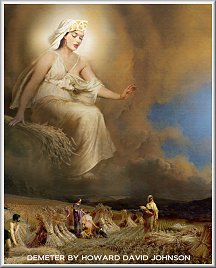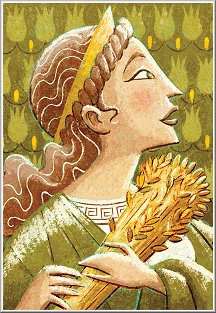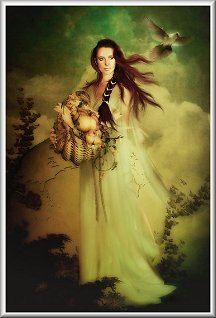
DEMETER
CLICK TO ENLARGE

DEMETER
CLICK TO ENLARGE

DEMETER
CLICK TO ENLARGE
|
DEMETER PAGE ONE
Demeter was the goddess of Corn and therefore also of the
Harvest, and her cult particularly flourished in the regions
where grain was grown: in the region of Eleusis, in the
Peloponnesus, in Crete, in Thrace and in Sicily.
She was the first to gather the corn, prepare and preserve it,
and to instruct mankind how to sow it. Demeter's cult titles
include Sito (wheat), because she is the bringer of food, grain
or corn, and Thesmophoros, which loosely translates as Bearer of
Divine Order/Unwritten Law, because of the civilizing aspect of
agriculture.
Demeter was one of the great divinities of the Greeks. The name
Demeter is alleged to be the same as gê mêtêr,
that is, Mother Earth, while others consider Deo, which is
synonymous with Demeter, as connected with dais and
dainumi, and as derived from the Cretan word dêai
(barley), so that Demeter would be the mother or giver of
barley, or of food generally.
She is also known as the Corn Mother, Chloe (green shoot),
Cthonia (in the ground) and Anesidora (sending up gifts from the
earth.) She is usually portrayed as serious and dignified,
dressed plainly in a long robe.
Her nurse was Eirene (Peace), making her a peace-loving and
law-giving deity. The beloved goddess of the harvest also
brought to humans the cultivation of grain (wheat and barley)
which, according to one legend, allowed them to stand upright.
Demeter was the goddess of the earth, and more especially of the
earth as producing fruit, and consequently of agriculture.
That's the reason ancient poets called human food or bread "the
gift of Demeter".
Also known as the goddess of fertility, Demeter was the daughter
of the Titans Cronus and Rhea and thus Zeus’ sister. Her other
Olympian siblings included Hades, Poseidon, Hestia and Hera.
Demeter was often portrayed on a chariot amid harvest images,
including grain, fruit and flowers. Her daughter Persephone was
regularly pictured with her in ancient depictions.
Even though she is most often associated as the Harvest goddess,
Demeter also presided over Marriage, the Cycle of Life and
Death, and the ancient Sacred Laws, which are the moral and
ethical codes taught by religious traditions.
For that reason she was worshipped especially by women. Her
priestess also initiated young married people into the duties of
their new situation, offering marital instruction and guidance.
She was often represented in works of art, though scarcely one
entirely intact statue of her is preserved. Her image as
presented by the ancients resembled that of Hera, queen of the
Olympians, in its maternal character, but had a softer
expression, and her eyes were less widely opened.
She was represented sometimes in a sitting attitude, sometimes
walking, and sometimes riding in a chariot drawn by horses or
dragons, but always in fully dressed. Around her head she wore a
garland of corn-ears or a simple ribband, and in her hand she
held a scepter, corn ears or a poppy, which is her sacred
flower.
Sometimes she is shown holding a torch and the mystic basket.
She appears most frequently on gems and vases.
Along with Dionysus (known in Roman as Bacchus, god of Wine)
Demeter was one of the two most important gods in
the everyday lives of people. While many other gods did little
to help mortal people unless it suited their needs, these two
were truly mankind’s best friends.
What also made them very different from other gods, was that
they were the only two to have known and felt suffering and true
grief, while the other gods for the most part lived happy and
blissful lives, feasting on nectar and ambrosia up on lofty
Mount Olympus.
The cause of Demeter's suffering was the kidnapping of her
daughter, Persephone, by the dreaded lord of the Underworld,
Hades. He stole the young maiden and brought her to his domain
to be his wife.
Let's take a look at the myth of Demeter and Persephone next.
DEMETER CONTINUES ON
PAGE TWO
LOTS MORE STORIES AND A TON OF PIX
CLICK HERE!

|







